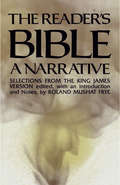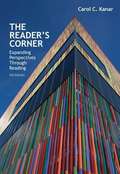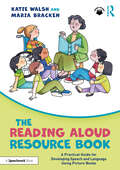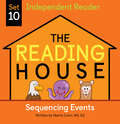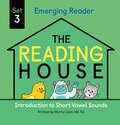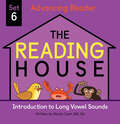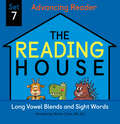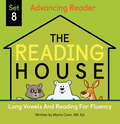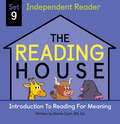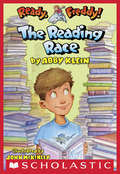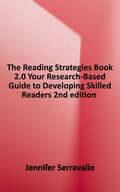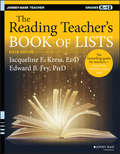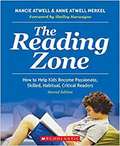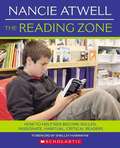- Table View
- List View
The Reader's Bible, A Narrative: Selections from the King James Version
by Roland Mushat FryeUnderstanding the Bible as an account of the unfolding revelation of God to humankind through history, Roland Mushat Frye suggests that the many sub-plots, monologues, and reflections of the Bible compose a coherent story that continues through both the Old and New Testaments. "The convictions of the Bible, to be sure, are the convictions of religion and ethics," he writes, "but the methods are the methods of literature." Carefully arranging a selection of excerpts that comprise approximately one-fourth of the entire Bible, he enables the reader to follow chronologically the main narrative as well as the most significant asides. With introductory and explanatory material providing transition and background information, the reader progresses from book to book as from chapter to chapter in a novel. Thus, this is called The Reader's Bible because it may be read as a narrative, as a story that unifies consecutive events through which the character of God gradually unfolds. God first appears in the opening of Genesis with the creation of the universe; against this backdrop the human drama is played. We see Everyman and Everywoman endowed with a life in harmony as long as they accept the primacy of God. When they repudiate this primacy, chaos replaces harmony and they find themselves in a wilderness rather than in a garden. God then turns from the attempt to create a righteous and peaceful order for all of humanity to a concentration on one segment of humanity-the race of Abraham--for the development of a conception of human personality and community that may serve as a pattern for all human beings. Professor Frye writes that however miraculous the entrances of God upon the stage may appear to be, they do constitute entrances into ordinary human affairs. These encounters Invite us to look both within and beyond them to what they reveal about God and about ourselves. Concerned with the matter of living here and hereafter, the different biblical histories and stories are brought together to provide cumulative insight into human nature and destiny.
The Reader's Brain
by Yellowlees DouglasHave you ever found yourself re-reading the same sentence four or five times and thought 'I should get more sleep'? Are you clueless as to why one paragraph just seems to 'flow' while you simply can't recall the contents of another? Guess what: you are not alone. Even the best writers fail to grasp why their writing works. The Reader's Brain is the first science-based guide to writing, employing cutting-edge research on how our minds process written language, to ensure your writing can be read quickly, assimilated easily, and recalled precisely - exactly what we need to transform anyone into a highly effective writer. Using the 5Cs - clarity, continuity, coherence, concision, and cadence - this book combines irreverent humour with easy-to-follow principles that will make readers perceive your sentences, paragraphs, and documents to be clear, concise, and effective.
The Reader's Corner: Expanding Perspectives Through Reading (Fifth Edition)
by Carol C. KanarWritten for the upper-level developmental courses, THE READER'S CORNER features compelling reading selections and strategies that build strong critical-thinking and analytical skills. The readings vary in length and reflect a range of sources, from the Associated Press to the works of authors such as Shankar Vedantam, Caroline Hwang, Donna Brazile, and Leonard Pitts. Longer selections allow students to apply new skills and strategies to material similar to what they will encounter in other college courses. Unlike traditional texts that teach reading skills through "skill and drill" exercises, THE READER'S CORNER inspires students to think critically about what they read by offering a more authentic reading experience. The fifth edition presents refocused themes in Part 2, "Changing Times," and Part 5, "Life and Work in a Digital Age," and a new pair of readings in each part that look closely at opposing viewpoints on a topic. A robust pre- and post-reading apparatus accompanies each selection and helps build students' vocabulary, critical-reading, and critical-thinking skills.
The Reading Aloud Resource Book: A Practical Guide for Developing Speech and Language Using Picture Books
by Katie Walsh Maria BrackenThis practical guide is the ideal tool for the busy practitioner or speech and language therapist to provide an effective, meaningful, and contextualised approach to language development using picture books. Drawing from up-to-date, evidence-based research, each chapter shows you how to get the most out of picture books to support language development, with a focus on the range of opportunities that reading aloud can bring. The guide offers a complete package to promote speech, language, and early literacy, and to enrich language comprehension, vocabulary, phonological awareness, and oral language – all by using books to provide a context for meaningful language learning. The resource also includes advice on how to develop intervention goals and outcome measures for reading aloud, with practical suggestions covering topics from creating a reading routine and book nooks, to encouraging reluctant readers and reading aloud challenges. Language skills are essential for academic, social and communication success and this reading aloud resource will be valuable reading for early year educators, primary teachers, and speech and language therapists working with young children aged 0-7.
The Reading House Set 10: Sequencing Events (The Reading House #10)
by The Reading HouseREADY, SET, READ! Introduce your child to reading on their own with this fun and colorful box set! Inside you&’ll find 12 leveled storybooks featuring friendly animal characters, an activity sheet, and a helpful parent guide. Perfect for independent readers! Kids will learn to: • Follow the order of events in a story• Reinforce decoding skills and practice sight word recognition• Understand non-fiction concepts like behaviors, characteristics, and adaptations of animals THE READING HOUSE is a step-by-step learn-to-read program that takes kids aged 4-7 from letter recognition all the way up to independent reading. With four distinct stages, choosing the box set that&’s just right for your new reader is simple. The sets in Stage Four: Independent Reader build reading comprehension and help children read on their own. The simple stories, decodable words, picture cues, and bright, colorful artwork make it easy to raise a confident, happy reader!
The Reading House Set 11: Comparing and Contrasting (The Reading House #11)
by The Reading HouseREADY, SET, READ! Introduce your child to reading on their own with this fun and colorful box set! Inside you&’ll find 12 leveled storybooks featuring friendly animal characters, an activity sheet, and a helpful parent guide. Perfect for independent readers! Kids will learn to: • Compare and contrast while reading for meaning• Reinforce decoding skills and practice sight word recognition• Understand non-fiction concepts like behaviors, characteristics, and adaptations of animals THE READING HOUSE is a step-by-step learn-to-read program that takes kids aged 4-7 from letter recognition all the way up to independent reading. With four distinct stages, choosing the box set that&’s just right for your new reader is simple. The sets in Stage Four: Independent Reader build reading comprehension and help children read on their own. The simple stories, decodable words, picture cues, and bright, colorful artwork make it easy to raise a confident, happy reader!
The Reading House Set 12: Cause and Effect Relationships (The Reading House #12)
by The Reading HouseREADY, SET, READ! Introduce your child to reading on their own with this fun and colorful box set! Inside you&’ll find 12 leveled storybooks featuring friendly animal characters, an activity sheet, and a helpful parent guide. Perfect for independent readers! Kids will learn to:• Understand cause and effect relationships• Reinforce decoding skills and practice sight word recognition• Understand non-fiction concepts like behaviors, characteristics, and adaptations of animals THE READING HOUSE is a step-by-step learn-to-read program that takes kids aged 4-7 from letter recognition all the way up to independent reading. With four distinct stages, choosing the box set that&’s just right for your new reader is simple. The sets in Stage Four: Independent Reader build reading comprehension and help children read on their own. The simple stories, decodable words, picture cues, and bright, colorful artwork make it easy to raise a confident, happy reader!
The Reading House Set 1: Letter Recognition A-L (The Reading House #1)
by The Reading HouseREADY, SET, READ! Introduce your child to the letters of the alphabet with this fun and colorful box set from the experts at Random House! Inside you&’ll find 12 leveled storybooks featuring friendly animal characters, an activity sheet, and a helpful parent guide. Perfect for early readers just getting started! Kids will learn to:• Recognize lower and uppercase letters A-L •Identify beginning word sounds • Connect beginning sounds and words THE READING HOUSE is a step-by-step learn-to-read program that takes kids aged 4-7 from letter recognition all the way up to independent reading. With four distinct stages, choosing the box set that&’s just right for your child is simple. The sets in Stage One: Getting Started introduce children to the 26 upper- and lower-case letter pairs in the alphabet. The simple stories, decodable words, picture cues, and bright, colorful artwork make it easy to raise a confident, happy reader!
The Reading House Set 2: Letter Recognition M-Z (The Reading House #2)
by The Reading HouseREADY, SET, READ! Introduce your child to the letters of the alphabet with this fun and colorful box set! Inside you&’ll find 12 leveled storybooks featuring friendly animal characters, an activity sheet, and a helpful parent guide. Perfect for early readers just getting started! Kids will learn to: •Recognize lower and uppercase letters M-Z •Identify beginning word sounds •Connect beginning sounds and words THE READING HOUSE is a step-by-step learn-to-read program that takes kids aged 4-7 from letter recognition all the way up to independent reading. With four distinct stages, choosing the box set that&’s just right for early readers is simple. The sets in Stage One: Getting Started introduce children to the 26 upper- and lower-case letter pairs in the alphabet. The simple stories, decodable words, picture cues, and bright, colorful artwork make it easy to raise a confident, happy reader!
The Reading House Set 3: Introduction to Short Vowel Sounds (The Reading House #3)
by The Reading HouseREADY, SET, READ! Introduce your child to short vowel sounds with this fun and colorful box set! Inside you&’ll find 12 leveled storybooks featuring friendly animal characters, an activity sheet, and a helpful parent guide. Perfect for emerging readers! Kids will learn to:• Recognize consistent short vowel sounds and word families• Blend consistent short vowel word families with initial consonants and diagraphs• Read sentences with simple short vowel sight words THE READING HOUSE is a step-by-step learn-to-read program that takes kids aged 4-7 from letter recognition all the way up to independent reading. With four distinct stages, choosing the box set that&’s just right for your reader is simple. The sets in Stage Two: Emerging Reader get children comfortable with short vowel sounds and words. The simple stories, decodable words, picture cues, and bright, colorful artwork make it easy to raise a confident, happy reader!
The Reading House Set 4: Short Vowel Clusters and Sight Words (The Reading House #4)
by The Reading HouseREADY, SET, READ! Introduce your child to short vowel sounds with this fun and colorful box set! Inside you&’ll find 12 leveled storybooks featuring friendly animal characters, an activity sheet, and a helpful parent guide. Perfect for emerging readers! Kids will learn to:• Recognize short vowel sight words• Reinforce short vowel sound clusters• Read more complex sentences THE READING HOUSE is a step-by-step learn-to-read program that takes kids aged 4-7 from letter recognition all the way up to independent reading. With four distinct stages, choosing the box set that&’s just right for your reader is simple. The sets in Stage Two: Emerging Reader get children comfortable with short vowel sounds and words. The simple stories, decodable words, picture cues, and bright, colorful artwork make it easy to raise a confident, happy reader!
The Reading House Set 5: Short Vowels and Reading for Fluency (The Reading House #5)
by The Reading HouseREADY, SET, READ! Introduce your child to short vowel sounds with this fun and colorful box set! Inside you&’ll find 12 leveled storybooks featuring friendly animal characters, an activity sheet, and a helpful parent guide. Perfect for emerging readers! Kids will learn to:• Decode short vowel clusters, rhyming words, and sight words• Begin to recognize story elements like setting, plot, and character• Build the confidence to read simple stories independently THE READING HOUSE is a step-by-step learn-to-read program that takes kids aged 4-7 from letter recognition all the way up to independent reading. With four distinct stages, choosing the box set that&’s just right for your reader is simple. The sets in Stage Two: Emerging Reader get children comfortable with short vowel sounds and words. The simple stories, decodable words, picture cues, and bright, colorful artwork make it easy to raise a confident, happy reader!
The Reading House Set 6: Introduction to Long Vowel Sounds (The Reading House #6)
by The Reading HouseREADY, SET, READ! Introduce your child to long vowel sounds with this fun and colorful box set! Inside you&’ll find 12 leveled storybooks featuring friendly animal characters, an activity sheet, and a helpful parent guide. Perfect for advancing readers! Kids will learn to:• Recognize consistent long vowel sounds and word families• Blend consistent long vowel word families with initial consonants and diagraphs• Read sentences with simple long vowel sight words THE READING HOUSE is a step-by-step learn-to-read program that takes kids aged 4-7 from letter recognition all the way up to independent reading. With four distinct stages, choosing the box set that&’s just right for your reader is simple. The sets in Stage Three: Advancing Reader help children master long vowel sounds and words. The simple stories, decodable words, picture cues, and bright, colorful artwork make it easy to raise a confident, happy reader!
The Reading House Set 7: Long Vowel Blends and Sight Words (The Reading House #7)
by The Reading HouseREADY, SET, READ! Introduce your child to long vowel sounds with this fun and colorful box set! Inside you&’ll find 12 leveled storybooks featuring friendly animal characters, an activity sheet, and a helpful parent guide. Perfect for advancing readers! Kids will learn to:• Recognize long vowel sight words• Reinforce long vowel sounds• Read more complex sentences THE READING HOUSE is a step-by-step learn-to-read program that takes kids aged 4-7 from letter recognition all the way up to independent reading. With four distinct stages, choosing the box set that&’s just right for your reader is simple. The sets in Stage Three: Advancing Reader help children master long vowel sounds and words. The simple stories, decodable words, picture cues, and bright, colorful artwork make it easy to raise a confident, happy reader!
The Reading House Set 8: Long Vowels and Reading for Fluency (The Reading House #8)
by The Reading HouseREADY, SET, READ! Introduce your child to long vowel sounds with this fun and colorful box set! Inside you&’ll find 12 leveled storybooks featuring friendly animal characters, an activity sheet, and a helpful parent guide. Perfect for advancing readers! Kids will learn to: • Decode long vowel clusters, rhyming words, and sight words• Begin to recognize story elements like setting, plot, and character• Build the confidence to read simple stories independently THE READING HOUSE is a step-by-step learn-to-read program that takes kids aged 4-7 from letter recognition all the way up to independent reading. With four distinct stages, choosing the box set that&’s just right for your reader is simple. The sets in Stage Three: Advancing Reader help children master long vowel sounds and words. The simple stories, decodable words, picture cues, and bright, colorful artwork make it easy to raise a confident, happy reader!
The Reading House Set 9: Introduction to Reading for Meaning (The Reading House #9)
by The Reading HouseREADY, SET, READ! Introduce your child to reading on their own with this fun and colorful box set! Inside you&’ll find 12 leveled storybooks featuring friendly animal characters, an activity sheet, and a helpful parent guide. Perfect for independent readers! Kids will learn to: • Identify a story's main idea and details• Reinforce decoding skills and practice sight word recognition• Understand non-fiction concepts like behaviors, characteristics, and adaptations of animals THE READING HOUSE is a step-by-step learn-to-read program that takes kids aged 4-7 from letter recognition all the way up to independent reading. With four distinct stages, choosing the box set that&’s just right for your new reader is simple. The sets in Stage Four: Independent Reader build reading comprehension and help children read on their own. The simple stories, decodable words, picture cues, and bright, colorful artwork make it easy to raise a confident, happy reader!
The Reading Lives of Teens: Research and Practice
by Chin Ee LohIn these changing times of global flows of media and technologies and reports of declining reading enjoyment, researchers, policymakers and educators need to engage anew with essential issues of what counts as reading, what kinds of reading matter and how to support teen reading engagement in school and out-of-school settings.Bringing together contributions from well-known and emerging adolescent literacy researchers from different disciplinary perspectives, this edited collection consolidates contemporary research on teens’ volitional print and digital reading, whether in school or out-of-school contexts. The first part of the book offers overviews of what teens are reading, followed by chapters on community support on reading and new ways of researching teen reading. With chapters from North America, Europe, Australia, Asia and the Middle East, the collection will offer multifaceted and complex insights into what, how and why teens read in different contexts. Reflection questions at the end of each chapter encourage readers to consider how the research can be applied in their own research, policy and practice contexts.This book will be of interest to researchers, policymakers and educators who are invested in supporting adolescent-engaged reading with evidence-based policies and strategies.
The Reading Mind: A Cognitive Approach to Understanding How the Mind Reads
by Daniel T. WillinghamPRAISE FOR THE READING MIND "Willingham's ability to make cognitive research on reading coherent and comprehensible is exceptional. This book should be standard fare in every doctoral education course on reading." —Isabel L. Beck, Professor Emerita, School of Education, University of Pittsburgh "This is another of Willingham's essential books for educational professionals, and anyone else interested in the reading process—telling them the cognitive science and practical implications of research in the domain of reading. No one does this kind of book better than Willingham!" —Keith E. Stanovich, author of Progress in Understanding Reading and The Rationality Quotient "Willingham captures the magic of reading while simultaneously demystifying how we read. He brings key experimental findings to light as he takes us on the journey from recognizing individual words to constructing meaning from text. Beautifully written, clear and accessible, yet still embracing complexities rather than shying away from them—this book is essential reading for anyone interested in how we read." —Kate Nation, professor of Experimental Psychology, University of Oxford; fellow and tutor in Psychology, St. John's College "What goes on in the mind as we read? How do people learn to read? What motivates some to read more than others? For those curious about these questions, and for those who care about children learning to read and growing as readers, this delightful book explains this highly complex topic through fascinating studies and lively examples. With probing questions included, The Reading Mind will make a terrific book club read or textbook." —Ellen McIntyre, dean and professor, College of Education, University of North Carolina, Charlotte "Willingham's work will deepen your understanding of the many facets of reading and literacy, as well as how the brain processes what amounts to an astoundingly complex and historically unlikely process. This book should be required reading for anyone with a vested interest in the written word." —Kristofor Lauricella, History teacher, High School for Youth & Community Development, Brooklyn, New York
The Reading Race (Ready, Freddy! #27)
by Abby KleinFreddy is back, and ready to compete in the Reading Race!Freddy's class is competing in a read-a-thon, and the student who reads for the most minutes will win five free books -- and the class will win an author visit, too! Freddy plans to win this contest... even if it means staying up all night!
The Reading Strategies Book 2. 0: Your Research-Based Guide to Developing Skilled Readers
by Jennifer SerravalloEvidence-based, responsive instruction made easier. - 100 new and 200 heavily revised strategies - 700+ references or links to research studies - Skill progressions for progress monitoring - 200 new student-facing charts - New strategies for advanced middle school readers - Recently published mentor texts used in lesson examples Serravallo brings a practical and proven approach to helping teachers help kids develop as skilled readers. The Reading Strategies Book 2.0 is designed to work in every K-8 classroom, providing strategies and lesson plans for every type of reader. The user-friendly design of The Reading Strategies Book 2.0 makes it easy to find strategies, prompts, and tips that meet every student where they are now. Save prep time and support readers' progress toward skills mastery with classroom-ready features such as revised lesson language with updated mentor texts, teaching tips with advice for differentiation, and mostly new student-facing charts. Whether you are looking for powerful and engaging lessons for whole-class teaching, need to supplement your core curriculum with small-group instruction, want to improve the quality of content-area instruction, or need ideas for intervention, The Reading Strategies Book 2.0 will help you connect research to practice.
The Reading Strategies Book: Your Everything Guide To Developing Skilled Readers
by Jennifer SerravalloWith hit books that support strategic reading through conferring, small groups, and assessment, Jen Serravallo gets emails almost daily asking, "Isn't there a book of the strategies themselves?" Now there is. <P><P> "Strategies make the often invisible work of reading actionable and visible," Jen writes. In The Reading Strategies Book, she collects 300 strategies to share with readers in support of thirteen goals-everything from fluency to literary analysis. Each strategy is cross-linked to skills, genres, and Fountas & Pinnell reading levels to give you just-right teaching, just in time. With Jen's help you'll: <br>develop goals for every reader <br>give students step-by-step strategies for skilled reading <br>guide readers with prompts aligned to the strategies <br>adjust instruction to meet individual needs with Jen's Teaching Tips <br>craft demonstrations and explanations with her Lesson Language <br>learn more with Hat Tips to the work of influential teacher-authors. <P><P>Whether you use readers workshop, Daily 5/CAFE, guided reading, balanced reading, a core reading program, whole-class novels, or any other approach, The Reading Strategies Book will complement and extend your teaching. Rely on it to plan and implement goal-directed, differentiated instruction for individuals, small groups, and whole classes. <P><P> "We offer strategies to readers to put the work in doable terms for those who are still practicing," writes Jen Serravallo. "The goal is not that they can do the steps of the strategy but that they become more comfortable and competent with a new skill." With The Reading Strategies Book, you'll have ways to help your readers make progress every day. <P><P> Visit heinemann.com/readingstrategiesbook/ where you'll find blog posts, videos from Jen Serravallo, community features, and more information on The Reading Strategies Book.
The Reading Teacher's Book of Lists
by Edward B. Fry Jacqueline E. KressThe essential handbook for reading teachers, now aligned with the Common Core The Reading Teacher's Book of Lists is the definitive instructional resource for anyone who teaches reading or works in a K-12 English language arts-related field. Newly revised and ready for instant application, this top seller provides up-to-date reading, writing, and language content in more than 240 lists for developing targeted instruction, plus section briefs linking content to research-based teaching practices. This new sixth edition includes a guide that maps the lists to specific Common Core standards for easy lesson planning, and features fifty brand-new lists on: academic and domain-specific vocabulary, foundation skills, rhyming words, second language development, context clues, and more. This edition also includes an expanded writing section that covers registers, signal and transition words, and writers' craft. Brimming with practical examples, key words, teaching ideas, and activities that can be used as-is or adapted to students' needs, these lists are ready to differentiate instruction for an individual student, small-group, or planning multilevel instruction for your whole class. Reading is the center of all school curricula due to recent state and federal initiatives including rigorous standards and new assessments. This book allows to you skip years of curating content and dive right into the classroom armed with smart, relevant, and effective plans. Develop focused learning materials quickly and easily Create unit-specific Common Core aligned lesson plans Link classroom practice to key research in reading, language arts and learning Adapt ready-made ideas to any classroom or level It's more important than ever for students to have access to quality literacy instruction. Timely, up to date, and distinctively smart, The Reading Teacher's Book of Lists should be on every English language arts teacher's desk, librarian's shelf, literacy coach's resource list, and reading professor's radar.
The Reading Teacher's Book of Lists (J-B Ed: Book of Lists)
by Edward B. Fry Jacqueline E. KressThe essential handbook for reading teachers, now aligned with the Common Core The Reading Teacher's Book of Lists is the definitive instructional resource for anyone who teaches reading or works in a K-12 English language arts-related field. Newly revised and ready for instant application, this top seller provides up-to-date reading, writing, and language content in more than 240 lists for developing targeted instruction, plus section briefs linking content to research-based teaching practices. This new sixth edition includes a guide that maps the lists to specific Common Core standards for easy lesson planning, and features fifty brand-new lists on: academic and domain-specific vocabulary, foundation skills, rhyming words, second language development, context clues, and more. This edition also includes an expanded writing section that covers registers, signal and transition words, and writers' craft. Brimming with practical examples, key words, teaching ideas, and activities that can be used as-is or adapted to students' needs, these lists are ready to differentiate instruction for an individual student, small-group, or planning multilevel instruction for your whole class. Reading is the center of all school curricula due to recent state and federal initiatives including rigorous standards and new assessments. This book allows to you skip years of curating content and dive right into the classroom armed with smart, relevant, and effective plans. Develop focused learning materials quickly and easily Create unit-specific Common Core aligned lesson plans Link classroom practice to key research in reading, language arts and learning Adapt ready-made ideas to any classroom or level It's more important than ever for students to have access to quality literacy instruction. Timely, up to date, and distinctively smart, The Reading Teacher's Book of Lists should be on every English language arts teacher's desk, librarian's shelf, literacy coach's resource list, and reading professor's radar.
The Reading Zone: How To Help Kids Become Passionate, Skilled, Habitual, Critical Readers
by Nancie Atwell Ann Atwell MerkelDecades of expert teaching and thoughtful observation of readers inform this expanded second edition of The Reading Zone. Dynamic teaching and writing partners, mother and daughter Atwell and Atwell Merkel show how to teach reading as a personal art―a way to develop passionate, critical readers for life―and how to build a schoolwide reading culture on self-selected, voluminous reading. The authors describe the top ten conditions for making engaged classroom reading possible for students at all levels and share the ideas and structures that have helped their own students succeed.
The Reading Zone: How to Help Kids Become Skilled, Passionate, Habitual, Critical Readers
by Nancie AtwellLong an advocate of frequent, voluminous reading in schools, the author draws on evidence gathered in twenty years of classroom teaching to make the case for reading workshop more powerful than ever. The book establishes the top ten conditions for making engaged classroom reading possible for students at all levels and provides the practical support and structures necessary for achieving them.
